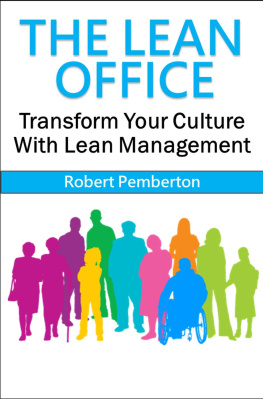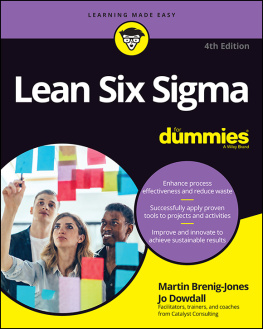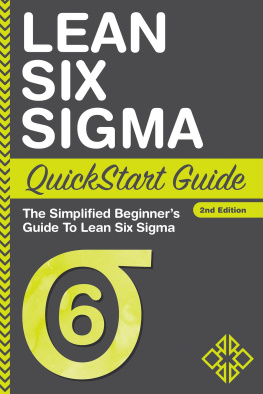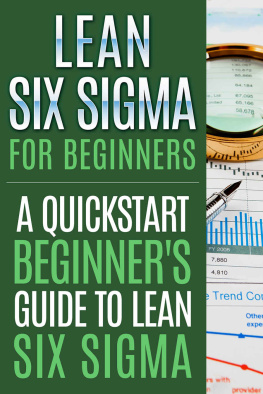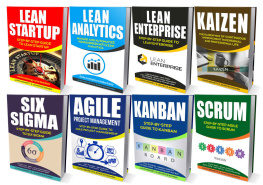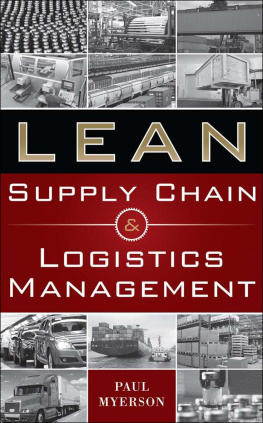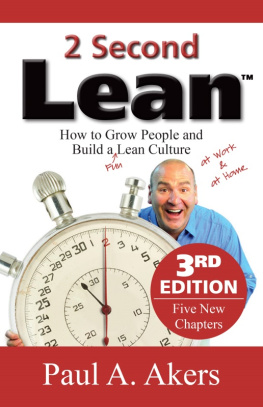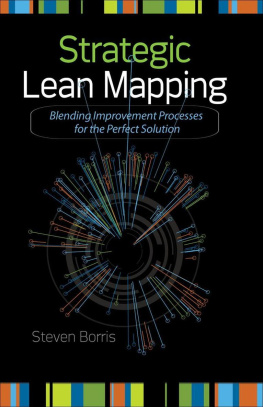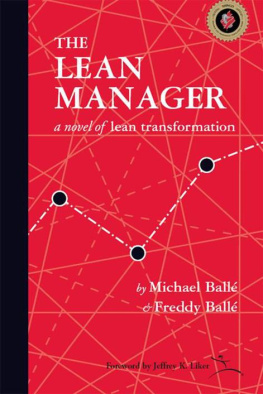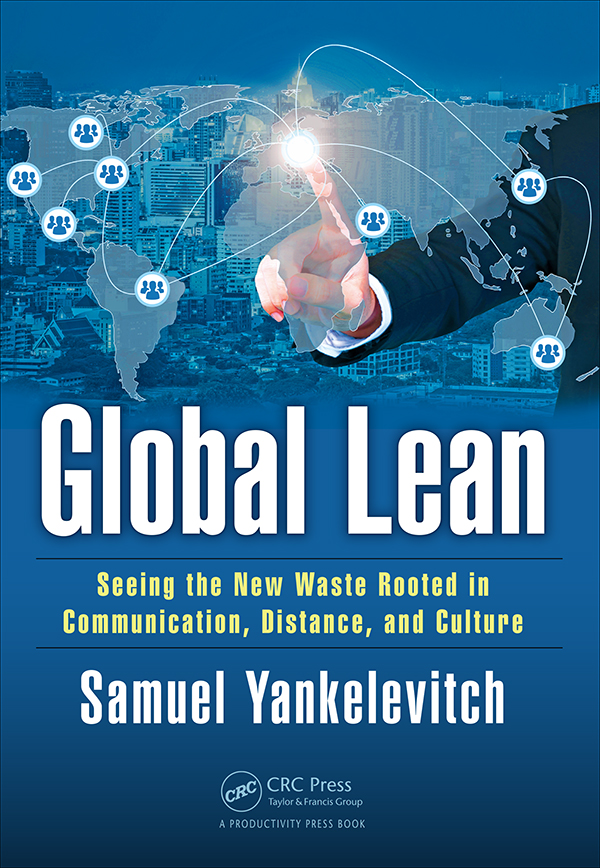Contents
Global Lean
Seeing the New Waste Rooted in Communication, Distance, and Culture
Global Lean
Seeing the New Waste Rooted in Communication, Distance, and Culture
Samuel Yankelevitch

CRC Press
Taylor & Francis Group
6000 Broken Sound Parkway NW, Suite 300
Boca Raton, FL 33487-2742
2017 by Taylor & Francis Group, LLC
CRC Press is an imprint of Taylor & Francis Group, an Informa business
No claim to original U.S. Government works
Printed on acid-free paper
Version Date: 20160818
International Standard Book Number-13: 978-1-4987-7334-8 (Paperback)
This book contains information obtained from authentic and highly regarded sources. Reasonable efforts have been made to publish reliable data and information, but the author and publisher cannot assume responsibility for the validity of all materials or the consequences of their use. The authors and publishers have attempted to trace the copyright holders of all material reproduced in this publication and apologize to copyright holders if permission to publish in this form has not been obtained. If any copyright material has not been acknowledged please write and let us know so we may rectify in any future reprint.
Except as permitted under U.S. Copyright Law, no part of this book may be reprinted, reproduced, transmitted, or utilized in any form by any electronic, mechanical, or other means, now known or hereafter invented, including photocopying, microfilming, and recording, or in any information storage or retrieval system, without written permission from the publishers.
For permission to photocopy or use material electronically from this work, please access www.copyright.com (http://www.copyright.com/) or contact the Copyright Clearance Center, Inc. (CCC), 222 Rosewood Drive, Danvers, MA 01923, 978-750-8400. CCC is a not-for-profit organization that provides licenses and registration for a variety of users. For organizations that have been granted a photocopy license by the CCC, a separate system of payment has been arranged.
Trademark Notice: Product or corporate names may be trademarks or registered trademarks, and are used only for identification and explanation without intent to infringe.
Library of Congress Cataloging-in-Publication Data
Names: Yankelevitch, Sam, author.
Title: Global lean : seeing the new waste rooted in communication, distance, and culture / Samuel Yankelevitch.
Description: Boca Raton, FL : CRC Press, 2016. | Includes bibliographical references and index.
Identifiers: LCCN 2016023252 | ISBN 9781498773348 (alk. paper)
Subjects: LCSH: International business enterprises--Managementt. | Management--Cross-cultural studies. | Organizational effectiveness--Cross-cultural studies. | Production control.
Classification: LCC HD62.4 .Y355 2016 | DDC 658.4/013--dc23
LC record available at https://lccn.loc.gov/2016023252
Visit the Taylor & Francis Web site at
http://www.taylorandfrancis.com
and the CRC Press Web site at
http://www.crcpress.com
This book is dedicated to Aron Levy, my grandfather and my mentor, who insisted that the most valuable assets in our business are the human beings that individually contribute to getting things done collectively. Regardless of the global developments and technological advances he would never see, and the ones I will never see, I believe humans will still have to interact with each other to accomplish those things that cannot be done independently.
Whether we interact effectively or not, is our choice.
Contents
Sam Yankelevitch provides us with a moving and all too recognizable story of a successful business driven to the brink of disaster by the upper managements failure to recognize the emerging business process constraints. Building on Lean and his understanding of the theory of constraints, Yankelevitch points out barriers and bottlenecks are not necessarily only within the four walls of our plants. In fact, some of our most vexing limitations may not be directly related to a physical transformation process at all.
Today, the complexity inherent in our global supply chains and the myriad of ways they intersect and interact with our operational processes create unique challenges that we are only now beginning to understand. From a Lean perspective, unidirectional messaging enabled through electronic channels such as email, information extracted from less than perfect software platforms, and language differences that exist among employees from different parts of the world who must work together can all create waste. Within the global enterprise, the gemba extends beyond the four walls of our service facilities or manufacturing plants, and into our supply chains.
Language, distance, and cultural differences contribute to variancethat in turn helps generate waste and this work traces specific examples that are typical to our global supply chains and our facilities. Yankelevitch points out that clear, unambiguous communication is required to reduce these variances. Thus, the road to supply chain waste elimination must include the detection, naming, and measuring of the variances caused by miscommunication.
The good news that Yankelevitch suggests is that new tools are not required to solve these emerging issues. Instead, the process improvement tools and the perspectives of Lean and Six Sigma, when used creatively and with determination can help us deal with the most frustrating communication and cultural issues inherent in working together across large distances. Process improvement experts, schooled in Lean and Six Sigma will recognize the tools of 5S, the PDCA cycle, VSM, and root cause analysis. However, they may not be familiar with the ways Yankelevitch demonstrates how these tools can be adapted to recognize where the value is being added, reduce variation, and eliminate waste in the supply chain communication processes that connect our operations.
This work presents us with a modern day parable. But instead of concluding with a moral, Yankelevitch provides a systematic process, integrated with well-understood tools, that will help any manager struggling to identify and eliminate waste-creating complexity and ambiguity that infects all our global supply chains.
Dr. John B. Jensen
Managing Director of the Global Supply Chain and Process Management Center
Darla Moore School of Business
University of South Carolina
When our world was hit by the Industrial Revolution which started in the eighteenth century, a wave of individuals and companies were motivated to come up with faster and cheaper ways to mass produce goods in order to satisfy an ambitious population moving from farming to urban living.
Most of these production systems focused on discrete, localized solutions where expansions of manufacturing facilities were often achieved within the same country and by using cookie-cutter formulas that had proven to be effective. Growth was made possible in the circumstances that these organizations were operating in.
Globalization is a newer wave that has been hitting our economies and it has changed the business context we once knew and were comfortable with. What worked once, might not be working so well today.
The need to integrate people and companies from different countries is continually shifting the way we were used to interacting and transacting in the direction of the goals and objectives of our organizations.


